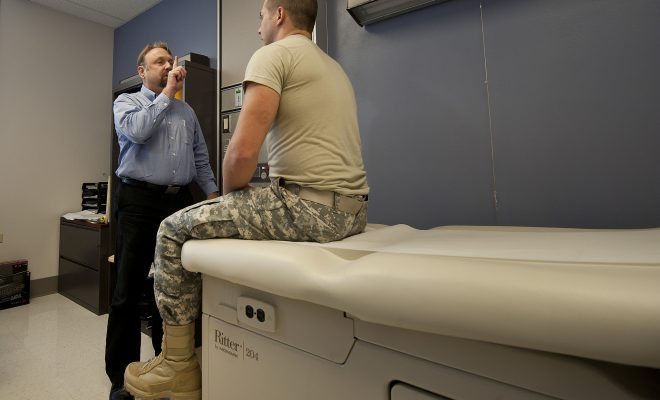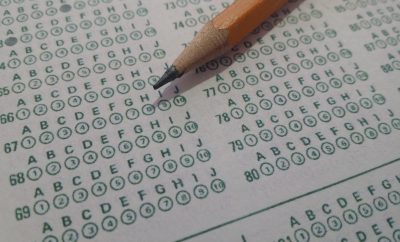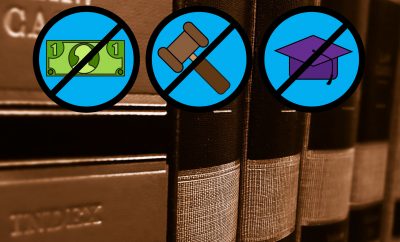 mage courtesy of [Army Medicine via Flickr]
mage courtesy of [Army Medicine via Flickr]
Health & Science
Vicarious Trauma: What is it and How Can Legal Culture Make it Worse?
Post-traumatic stress disorder, or PTSD, is often the subject of daily life experiences and intense internet debates on topics such as trigger warnings or the United States’ use of drones. Rates of PTSD are known to be dramatically affected by racism, sexism, queerphobia, and other forms of oppression.
But what about people who witness extreme traumas without necessarily experiencing the trauma themselves? Lawyers, doctors, social workers, and teachers all are at a high risk of experiencing something variously called vicarious trauma, secondary trauma, or compassion fatigue.
How might legal office cultures leave people from law students to defense attorneys extremely susceptible to vicarious trauma? And, significantly, what impact does this have on clients?
When Trauma is Contagious
Vicarious trauma is often popularly defined in terms of professionals, like lawyers, who work with people who have been traumatized. A form of PTSD in its own right, people enduring vicarious trauma experience symptoms similar to more widely recognized PTSD. The National Child Traumatic Stress Network refers to vicarious trauma as “secondary traumatic stress,” and defines it in this way:
Secondary traumatic stress is the emotional duress that results when an individual hears about the firsthand trauma experiences of another. Its symptoms mimic those of post-traumatic stress disorder (PTSD). Accordingly, individuals affected by secondary stress may find themselves re-experiencing personal trauma or notice an increase in arousal and avoidance reactions related to the indirect trauma exposure. They may also experience changes in memory and perception; alterations in their sense of self-efficacy; a depletion of personal resources; and disruption in their perceptions of safety, trust, and independence.
All of these trauma responses often lead to more commonly known experiences, such as anxiety, depression, sleeping problems, substance abuse, procrastination, and low self-esteem. The Vicarious Trauma Institute highlights, crucially, one of the key differences between vicarious trauma and directly experienced trauma: the intensity of vicarious trauma is dictated by being exposed, first-hand, “to traumatic stories day after day or respond to traumatic situations while having to control your reaction.” Not only are people being exposed to stories or direct experiences of violence, then, but lawyers, social workers, school counselors, teachers, etc. are trained or otherwise expected to keep a straight face and remain a bastion of calm for their clients and/or students. Commonly referred to as “burnout,” many professionals who chronically endure these feelings of vicarious trauma are forced to stop working, leave their field of specialization, or switch professions entirely.
Many who identify as working in a “helping profession”–doctors, lawyers, social workers, etc.–are affected deeply by vicarious trauma. At the Annual Convening of Crisis Intervention in Chicago in 1996, social worker Terri Spahn Nelson contributed the following perspective on vicarious trauma:
Many of us, especially those of us in a helping profession, are secondary witnesses to trauma almost everyday. As we listen to our clients tell about their trauma of incest, rape, domestic violence, alcoholic families or memories of childhood abuse, we bear witness to their victimization. We listen, we support and we validate their feelings and their experience. We offer them the opportunity to let go of some of their burden. As witnesses and healers, we can’t help but to take in some of the emotional pain they have left with us. As the client releases some of their pain, we take it in. By the end of the day, we’ve collected bits and pieces of accounts of trauma. We may have pictures in our mind or intense feelings running through our body. We’ve become a witness to rape, child abuse, domestic violence and death… In simple terms, this vicarious trauma as experienced by professionals and volunteers in the helping field.
By positioning oneself as being a “helping” professional, the burden of “taking in” clients’ trauma becomes a nearly unavoidable expectation. The sense of responsibility for clients–and attendant guilt for not having endured what clients did, especially when client outcomes are not positive–often prove overwhelming for professionals who enter fields expecting to “help” or “fix” clients’ lives.
Legal Burnout
This form of trauma is particularly prevalent in lawyers, who often witness clients’ trauma on a daily basis. Especially when responsibility is placed on lawyers to alleviate that trauma somehow–whether through their efforts to win a criminal or civil case–vicarious trauma can set in.
The lack of control associated with many cases deeply contributes to lawyers’ experiences of vicarious trauma: as Abby Anna Batko-Taylor and Melissa L. Shearer of the Voice of the Defense Online highlight, “In addition to dealing with interpersonal relationships with challenging clients, lawyers also experience personal and institutional pressure to produce results that many times are outside of their control.” Given the relationship between loss of control and trauma in general–traumatic events generally involve survivors losing control of some enormous aspect of life, and can result in a need to control as much as possible in order to feel safe–the feeling of not having control over the outcome of a case can deeply aggravate feelings of vicarious trauma for lawyers.
While issues of vicarious traumatization are not exclusive to lawyers, legal professionals often experience higher rates of vicarious trauma than professionals with similarly traumatized clients. In a study of criminal defense attorneys, defense lawyers were found to experience even higher rates of vicarious traumatization than mental health providers and social workers. Bigger caseloads and lack of supervision around trauma were offered as possible explanations for these higher rates.
According to a Science Alert report on a Macquarie University study on vicarious trauma among those who work in the field of criminal law, these attorneys experience disproportionately higher impacts and intensities of trauma from client interactions. The report goes on:
While often presenting an image of toughness and emotional detachment, it would seem that criminal defense lawyers and prosecutors are significantly more vulnerable to developing depression, stress and vicarious trauma than their non-criminal law colleagues.
These vulnerabilities have tremendous negative impacts on not only legal professionals, but on their clients. In an article for Canadian Lawyer Magazine, which includes clips from lawyers who experience vicarious trauma, cover story author donalee Moulton reports that:
Withdrawal is one of the common symptoms of vicarious trauma. Other symptoms include difficulties solving problems, a sense of being disconnected from work and home, and feelings of powerlessness. In response, lawyers and judges may take on greater responsibility, work longer hours, and attempt to exert greater control over others. They may also become more distant and withdrawn, more cynical, and even more accident prone. It is not unusual for victims of vicarious trauma to develop chronic health problems.
Withdrawal, difficulty solving problems, and issues with control all carry enormous risk of negatively impacting clients both on a case and an interpersonal level.
Despite the fact that unaddressed vicarious trauma is known to negatively affect clients, not to mention its chronic health impacts on lawyers themselves, many legal professionals do not seek or have access to affirmative work environments that can both assist with and help prevent vicarious traumatization.
What does office culture have to do with it?
Not only do many lawyers lack access to assistance and preventive care, but many legal cultures are such that vicarious trauma can take hold. Lack of trauma-related supervision and extremely high case loads as a measure of a lawyers’ skill contribute to a masculinized culture in which addressing and preventing vicarious trauma is perceived as taking time away from the ‘real work.’ In a similar way that the macho, product-oriented culture of journalism is often cited as a cause of vicarious trauma among journalists, lawyers–especially women and people of color–are often actively discouraged from emotional expression in the workplace. This emotional suppression alone has negative impacts on lawyers’ health, and also facilitates a masculinized culture that makes it nearly impossible to treat, let alone prevent, vicarious trauma.
While many workshops and presentations on vicarious trauma focus on individualized healing plans, it is more rare that action plans to ease vicarious trauma focus on organizational cultures. However, research shows that the most effective way to assist professionals who are likely to experience vicarious trauma is through structural changes to office and professional cultures, such as reduced and/or more diverse case loads, comprehensive healthcare provisions, holistic approaches to work and clients, effective supervision, explicit group support, and education.
So, What Can Be Done?
It is clear, then, that vicarious trauma impacts a vast array of people, particularly lawyer–most often defense attorneys and those who specialize in domestic violence, immigration, or family court. Emphasizing the importance of self-care is an important move toward providing healthy, effective, and sustainable services to clients, but it seems that structural changes to office and professional cultures, which are often very cut-throat, can go the longest way toward reducing the negative impacts that vicarious trauma has on both lawyers and clients.
Resources
Primary
Legal Profession Assistance Conference: A Desk Manual on Vicarious Trauma
National Child Traumatic Stress Network: Secondary Traumatic Stress
Vicarious Trauma Institute: What is Vicarious Trauma?
Additional
Voice for the Defense Online: Representing the Traumatized Client: The Case, the Client, and You
Pyscholawlogy: Lessons About Emotion Suppression for Lawyers
Science Alert: Crime Can Traumatize Lawyers
Huffington Post: A Mental-Health Epidemic in the Newsroom
Good Men Project: Escape the “Act Like a Man” Box
I








Comments